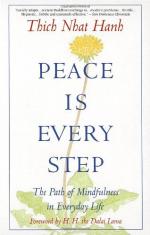
|
| Name: _________________________ | Period: ___________________ |
This test consists of 15 multiple choice questions and 5 short answer questions.
Multiple Choice Questions
1. What is Gethsemani?
(a) A sacred rock.
(b) An isolated forest.
(c) A monastery.
(d) A college.
2. What do non-sounds remind us to do?
(a) Breathe, smile, and care for others.
(b) Breathe, smile, and live fully in the moment.
(c) Breathe, smile, and commune with nature.
(d) Smile, acknowledge others, and live fully.
3. According to Hanh in "Aimlessness", what does the current culture promote?
(a) Wealth.
(b) Meditation.
(c) Achievement.
(d) Constant activity.
4. Who/what is one never able to escape?
(a) Mindfulness.
(b) Guilt.
(c) One's self.
(d) Gratitude.
5. At what university did Hanh tell the teachers and students to pause after a bell sounds?
(a) University of Colorado.
(b) McGill University.
(c) Harvard University.
(d) University of California.
6. In "Conscious Breathing", which two words can be used to facilitate being mindful of breathing?
(a) Inhale and exhale.
(b) In and out.
(c) Love and harmony.
(d) Peace and joy.
7. In "Flower Insights" who holds a flower before the monks?
(a) H.H. the Dalai Lama.
(b) The book's author.
(c) Buddha.
(d) Mahakashyapa.
8. In "Bells of Mindfulness", what must everyone make time for, according to Hanh?
(a) To honor all bells.
(b) To enjoy bells.
(c) To listen to non-sounds.
(d) To pray when church bells ring.
9. What benefits can be found only in oneself?
(a) Enlightenment and peace.
(b) Joy and peace.
(c) Peace and respect.
(d) Love and joy.
10. What group might react strongly to Hanh's views on hope?
(a) Christians.
(b) Buddhists.
(c) Mormons.
(d) Communists.
11. What does Hanh synchronize with his movements of using a scythe?
(a) His rest periods.
(b) His breathing.
(c) His voice.
(d) His thoughts.
12. What is the goal of meditation?
(a) Purification during meditation and throughout the day.
(b) Purification during meditation.
(c) Purification throughout the day.
(d) Purification during stressful times.
13. Which techniques can help individuals heal themselves emotionally and psychologically?
(a) Conscious breathing and meditating.
(b) Conscious breathing and mindful living.
(c) Conscious living and breathing.
(d) Meditating and mindful living.
14. According to Hanh, what is often a barrier to happiness?
(a) Stress.
(b) Love.
(c) Hope.
(d) Responsibility.
15. According to Hanh, what items should be in a family meditation room?
(a) Cushions, a bell, and a vase of flowers.
(b) Cushions, a candle, and a bell.
(c) Cushions and a vase of flowers.
(d) Cushions and a bell.
Short Answer Questions
1. Who smiles at the flower?
2. How many times should one breathe in and out before making a phone call?
3. When we walk hurriedly, what imprints are left on the Earth?
4. What is Hanh's synonym for aimlessness?
5. What organization is formed by Hanh in 1964?
|
This section contains 418 words (approx. 2 pages at 300 words per page) |

|




